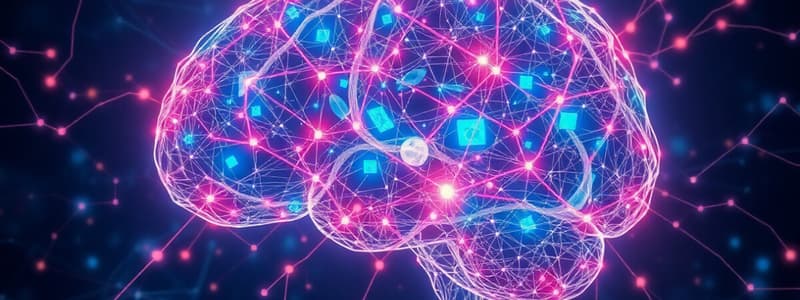Podcast
Questions and Answers
Which of the following techniques uses magnetic fields to stimulate brain activity?
Which of the following techniques uses magnetic fields to stimulate brain activity?
- Neural Interfaces
- Chemogenetics
- Single-Cell Transcriptomics/Proteomics
- Transcranial Magnetic Stimulation (TMS) (correct)
What is the primary function of neural interfaces?
What is the primary function of neural interfaces?
- To create more accurate brain models
- To observe brain activity using radioactive tracers
- To help people with paralysis control artificial limbs (correct)
- To study the expression of genes in individual neurons
Which technique utilizes chemicals to manipulate neurons?
Which technique utilizes chemicals to manipulate neurons?
- Artificial Intelligence (AI) in Neuroscience
- Epigenetics in the Brain
- Positron Emission Tomography (PET) Imaging
- Chemogenetics (correct)
What is the primary function of single-cell transcriptomics/proteomics?
What is the primary function of single-cell transcriptomics/proteomics?
Which of these techniques is NOT a brain imaging technique?
Which of these techniques is NOT a brain imaging technique?
What is the main goal of the Human Brain Project?
What is the main goal of the Human Brain Project?
Which project is specifically focused on understanding how consciousness, memory, and mental processes are formed?
Which project is specifically focused on understanding how consciousness, memory, and mental processes are formed?
What are Brain Organoids primarily used for?
What are Brain Organoids primarily used for?
Which project studies marmosets as a model for understanding higher brain function and neurodevelopmental diseases?
Which project studies marmosets as a model for understanding higher brain function and neurodevelopmental diseases?
What does the term "Neurogenesis" refer to?
What does the term "Neurogenesis" refer to?
What distinguishes Optogenetics from other brain research techniques?
What distinguishes Optogenetics from other brain research techniques?
Which project is funded by the U.S. National Institutes of Health (NIH)?
Which project is funded by the U.S. National Institutes of Health (NIH)?
What is the significance of the Brain Atlas in neuroscience research?
What is the significance of the Brain Atlas in neuroscience research?
Flashcards
Chemogenetics
Chemogenetics
A method using chemicals to manipulate neurons, similar to optogenetics.
Transcranial Magnetic Stimulation (TMS)
Transcranial Magnetic Stimulation (TMS)
A non-invasive technique using magnetic fields to stimulate brain activity.
Neural Interfaces (BCI)
Neural Interfaces (BCI)
Technology enabling direct communication between the brain and devices.
Single-Cell Transcriptomics/Proteomics
Single-Cell Transcriptomics/Proteomics
Signup and view all the flashcards
Epigenetics in the Brain
Epigenetics in the Brain
Signup and view all the flashcards
Connectome
Connectome
Signup and view all the flashcards
Brain Atlas
Brain Atlas
Signup and view all the flashcards
BRAIN Initiative
BRAIN Initiative
Signup and view all the flashcards
Human Brain Project
Human Brain Project
Signup and view all the flashcards
Neurogenesis
Neurogenesis
Signup and view all the flashcards
Brain Organoids
Brain Organoids
Signup and view all the flashcards
Optogenetics
Optogenetics
Signup and view all the flashcards
Brain/MINDS Project
Brain/MINDS Project
Signup and view all the flashcards
Study Notes
Connectome
- A complete map of all neural connections in the brain.
- Provides a wiring diagram to understand how neurons and brain regions connect.
- Helps understand consciousness, memory, and mental processes.
Brain Atlas
- A detailed map of brain cells and structures.
- Useful for understanding different brain cell types and their function.
- A comprehensive atlas will highlight human brain uniqueness compared to other species.
BRAIN Initiative
- A US research program focused on advancing brain study technologies.
- Funds research on brain imaging, neural mapping, and brain-computer interfaces.
Human Brain Project
- A European project integrating neuroscience and AI to understand the brain.
- Aims to create simulated brain models for studying brain disorders.
Brain/MINDS Project
- A Japanese neuroscience initiative studying marmoset brains.
- Marmosets are similar to humans in brain structure, making them useful models for higher brain function studies; neurodevelopmental diseases are also studied using marmosets.
Neurogenesis
- The process of generating new brain cells (neurons).
- Research suggests that neurogenesis may continue in adulthood; this could lead to treatments for neurodegenerative diseases.
Brain Organoids
- Miniature brain models created from stem cells.
- Used to study brain development and neurodegenerative diseases.
- Future potential for repairing damaged brain tissue.
Optogenetics
- A technique using light to control neuron activity.
- Neuroscientists activate or deactivate specific neurons to study their function.
Chemogenetics
- A technique using chemicals to manipulate neuron activity.
- Provides longer-lasting control over neural circuits, helping study behavior and brain disorders.
Transcranial Magnetic Stimulation (TMS)
- Non-invasive method using magnetic fields to stimulate brain activity.
- Used for treating depression and other neurological conditions, and for research on cognitive function.
Neural Interfaces (Brain-Computer Interfaces, BCI)
- Technology for direct brain-computer or brain-prosthetic communication.
- Enables people with paralysis to control artificial limbs or communicate via brain activity.
Single-Cell Transcriptomics/Proteomics
- Technology examining gene expression and protein composition in individual cells.
- Useful in understanding brain cell diversity and changes involved in diseases like neurodegenerative diseases.
Artificial Intelligence (AI) in Neuroscience
- Using AI and machine learning to study the brain.
- Speeds up analysis of brain scans, identifies disease markers, and creates more accurate brain models.
Epigenetics in the Brain
- Study of how environmental/lifestyle factors affect gene expression without changing the DNA sequence.
- Explains how factors like stress and nutrition affect brain health and mental disorders.
Positron Emission Tomography (PET) Imaging
- Brain imaging technique using radioactive tracers to observe brain activity.
- Used for research and diagnosing disorders like Alzheimer's disease.
Studying That Suits You
Use AI to generate personalized quizzes and flashcards to suit your learning preferences.
